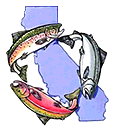Taking the Pulse: Measuring Restoration Success
April 29 - May 2, 2025
Integrated Model Development and Application to Game Changers for Salmon Recovery
29 April 2025
9:00am - 5:00pm
Workshop Coordinators; Darren Mierau, CalTrout; Eric Palkovacs, David Boughton, and Nate Mantua, UC Santa Cruz Fisheries Collaborative Program
See the Workshop Video Recording here.
See the Workshop Video Recording here.
Our community of dedicated scientists, resource managers, and restoration practitioners has worked tirelessly to turn the corner toward the recovery of abundant, self-sustaining populations that are able to withstand climate extremes and produce a harvestable surplus. That said, salmon recovery success stories are unfortunately few and far between. Realistically, what will it take? How will we get there? Where success has been realized, how was it achieved? And while salmon recovery success stories are few, the huge investments made toward watershed restoration, reform of instream flow management, hatchery genetics management, and technical advances in population monitoring and modeling represent important and lasting progress.
But there’s much more work ahead to achieve recovery goals. One important step forward is to replace the opportunistic and scatter-shot approach to restoration investment and implementation with watershed, basin-scale or system-scale efforts that can identify feasible, prioritized, and integrated suites of recovery actions (considering all the H’s) to increase the probability of measurable recovery outcomes. Acknowledging that a salmon-focused approach is not likely enough, how can we build broad coalitions based on a broader sense of co-benefits of improved river and wetland functioning?
In this workshop, we will (1) hear NOAA’s vision for transformational salmon recovery science, integrated modeling, and restoration programs; (2) hear case studies of salmon recovery success stories that highlight ingredients and recipes for effective planning and action; and (3) explore a few case studies aimed at system-level recovery plans and actions at a range of developmental stages.
Speakers and panelists in parts (2) and (3) of our agenda will address these two questions:
- What are/were the elements of a feasible near-term scenario to improve your populations?
- What are/were the elements of a scenario of full recovery?
Product: A synthesis article describing the workshop elements, lessons-learned about recipes for successful salmon recovery at the watershed/systems-level, and ideas for better linking quantitative integrated models to salmon recovery scenarios and programs.
Morning session: Recipes for Recovery
How Can Science Help Accelerate Recovery of Pacific Salmon? Steve Lindley, PhD, UC Santa Cruz Fisheries Collaborative Program
Salmon Recovery Success Stories from British Columbia - Context and Ingredients for Success, Jason Hwang, Pacific Salmon Foundation
Oregon Coast Coho - Recovery in Progress, Tim Elder, Wild Salmon Center
Paving Way for Coho Recovery in the Ten Mile Watershed: A Discussion of Landscape Level Restoration Investments Over 20 Years, Peter van de Burgt, North Coast Project Manager, The Nature Conservancy
Sharing Butte Creek, Jacob Katz, PhD, CalTrout
On the Renewal of Carmel River and its Steelhead, David A. Boughton, PhD, UC Santa Cruz Fisheries Collaborative Program
Klamath River – Understanding Where We Are Going, Sequencing Actions and Expectations, Tommy Williams PhD, UC Santa Cruz Fisheries Collaborative Program
Panel Discussion moderated by Nate Mantua
Afternoon session: Systems-Level Case Studies Underway
Conducting Watershed-Scale Restoration and Evaluating Reintroduction Pathways in Effort to Return Steelhead to Jalama Creek, Matthew Mensinger, University of California, Santa Cruz
Landowner Willingness as a Critical Variable in Integrated Modeling for Tuolumne River Salmon Recovery, Willam Eisenstein, PhD, River Partners; Katrina Harrison, Applied River Sciences
Reorienting to Recovery in the Central Valley: Adapting Decision Support Models to Advance Values Informed, Landscape Scale, and Equitable Decision-Making, Liz Stebbins, FlowWest; Alison Collins, The Metropolitan Water District of Southern California
Restoration in Reconciled Aquatic Ecosystems in the Wildland Urban Interface: Mill Creek, Lower Russian River Watershed, Sonoma County, California, Matt O’Connor, PhD, CEG, Coast Range Watershed Institute.
The Eel River on the Threshold of Transformative Change for Basinwide Salmonid Recovery, Darren Mierau, California Trout and Suzanne Rhoades, Applied River Sciences
Upper Shasta River Recovery Actions, Ada Fowler, CalTrout
Panel Discussion
